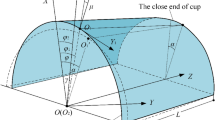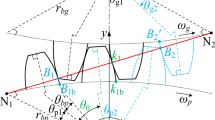Abstract
Harmonic drive (HD) is one of the core components of the robot joint. Studies show that tooth shape design and meshing characteristics of the HD directly affect the motion control accuracy and vibration characteristics of the robot. In the present study, common coordinate systems are established for three tooth profiles to analyze the differences between them. To this end, expressions for the double circular arc common-tangent tooth profile (DCTP), cycloid common tangent tooth profile (CCTP), and the involute tooth profile (ITP) are established in the same coordinate system. By applying the envelope conjugate theory, the conjugate existent domain (CED) and conjugate tooth profile (CTP) of the HD transmission are solved independently for each profile. Furthermore, the influences of tooth profile parameters on both the CTP and CED are analyzed. Obtained results show that both the DCTP and CCTP have more robust envelope processes when compared with the ITP. Moreover, it is found that both profiles can achieve the second conjugate and two-point conjugate engagement through applying variations in the tooth shape design parameters. It is concluded that meshing performances of the DCTP and CCTP are better than that of the ITP, providing guidelines for the future development of the harmonic reducer tooth shape design.
















Similar content being viewed by others
References
Musser, C. W. (1959). Strain Wave Gearing: US, 2906143[P].
Timofeyev, G. A., Kostikov, Y. V., Yaminsky, A. V., et al. (2018). Theory and practice of harmonic drive mechanisms [J]. IOP Conference Series Materials Science and Engineering, 468(1), 012010.
Anh-DucP, H.-J. (2018). High precision reducers for industrial robots driving 4th industrial revolution: State of arts, analysis, design, performance evaluation and perspective [J]. International Journal of Precision Engineering and Manufacturing-Green Technology, 5(4), 519–533.
Shen, Y. (1986). Tooth profile of harmonic gear drive [J]. Journal of Mechanical Transmission, 10(4), 52–105.
Ishikawa, S. (1989). Tooth profile of spline of strain wave, U.S. Patent No. 4823638.
Jeong, K. S., Lee, D. G., & Oh, S. H. (1995). Development of the composite flexspline for a cycloid-type harmonic drive using net shape manufacturing method [J]. Composite Structures, 32(1/4), 557–565.
Xin. . (2002). New method for research on engagement principle of harmonic drive [J]. China Mechanical Engineering, 13(3), 181–183.
Xin, H. (2011). Design for basic rack of harmonic drive with double-circular-arc tooth profile [J]. ZhongguoJixieGongcheng/China Mechanical Engineering, 22(6), 656–662.
Wang, J., Zhou, X., Li, J., et al. (2015). Double-circular-arc tooth profile of harmonic drive analysis based on different conjugate principle [J]. Journal of Sichuan University (Engineering Science Edition), 47, 166.
Wu, W., Yu, P., & Hou, Y. (2014). New design, new process of harmonic drive with short flexspline and its experiment[J]. Journal of Harbin Institute of Technology, 46(1), 40–46.
Chen, X., Lin, S., Xing, J., et al. (2011). Assembly model of harmonic gear based on elastic component deformation [J]. Computer Integrated Manufacturing Systems, 17(2), 338–343.
Dong, H., Ting, K. L., & Wang, D. (2011). Kinematic fundamentals of planar harmonic drives [J]. Journal of Mechanical Design, 133(1), 011007.
Dong, H., Wang, D., & Ting, K. L. (2011). Kinematic effect of the compliant cup in harmonic drives. The ASME Journal of Mechanical Design, 133(5), 051004.
Oguz., Kayabasi., Fehmi E. . (2007). Shape optimization of tooth profile of a flexspline for a harmonic drive by finite element modelling [J]. Materials & Design, 28(2), 441–447.
Yang, Y., Wang, J., Zhou, Q., et al. (2016). Optimization design for flexspline tooth profile parameters of double-circular-arc harmonic drives [J]. Journal of Sichuan University (Engineering Science Edition), 48(1), 186–193.
Chen, G., Li, H., & Liu, Y. (2019). Double-arc harmonic gear profile design and meshing analysis for multi-section conjugation [J]. Advances in Mechanical Engineering, 11(5), 1–14.
Chen, X., Liu, Y., Xing, J., et al. (2014). The parametric design of double-circular-arc tooth profile and its influence on the functional backlash of harmonic drive[J]. Mechanism and Machine Theory, 73, 1–24.
Pacana, J., Witkowski, W., & Mucha, J. (2017). FEM analysis of stress distribution in the hermetic harmonic drive flexspline [J]. Strength of Materials, 49(1), 1–11.
Zou, C., Tao, T., Jiang, G., et al. (2013). Deformation and stress analysis of short flexspline in the harmonic drive system with load, 2013 IEEE International Conference on Mechatronics and Automation, Takamatsu, pp. 676–680.
Yang, C., Hu, Q., Liu, Z., et al. (2020). Analysis of the partial axial load of a very thin-walled spur-gear (Flexspline) of a harmonic drive. International Journal of Precision Engineering and Manufacturing, 21, 1333–1345.
Yao, Y., Chen, X., Xing, J., et al. (2020). Tooth effects on assembling bending stress of flexible tooth rim in harmonic drive [J]. Mechanism and Machine Theory, 150, 1–13.
Li, X., Song, C., Yang, Y., et al. (2020). Optimal design of wave generator profile for harmonic gear drive using support function [J]. Mechanism and Machine Theory, 152, 1–13.
Hu, Q., Liu, Z., Yang, C., et al. (2021). Research on dynamic transmission error of harmonic drive with uncertain parameters by an interval method[J]. Precision Engineering, 61, 285–300.
Zhang, X., Jiang, G., Zhang, H., et al. (2020). Time-dependent reliability analysis of harmonic drive based on transient FEA and accelerated life test. Engineering Computations, 37(7), 2293–2317.
Acknowledgements
The authors would like to thank the National Natural Science Foundation of China No. 51805012 and National Key Research and Development Program of China No. 2020YFB2008200 for supporting the research.
Author information
Authors and Affiliations
Corresponding author
Ethics declarations
Conflict of interest
The authors declare that they have no known competing financial interests or personal relationships that could have appeared to influence the work reported in this paper.
Additional information
Publisher's Note
Springer Nature remains neutral with regard to jurisdictional claims in published maps and institutional affiliations.
Rights and permissions
About this article
Cite this article
Yang, C., Ma, H., Zhang, T. et al. Research on Meshing Characteristics of Strain Wave Gearing with Three Different Types of Tooth Profiles. Int. J. Precis. Eng. Manuf. 22, 1761–1775 (2021). https://doi.org/10.1007/s12541-021-00575-1
Received:
Revised:
Accepted:
Published:
Issue Date:
DOI: https://doi.org/10.1007/s12541-021-00575-1




